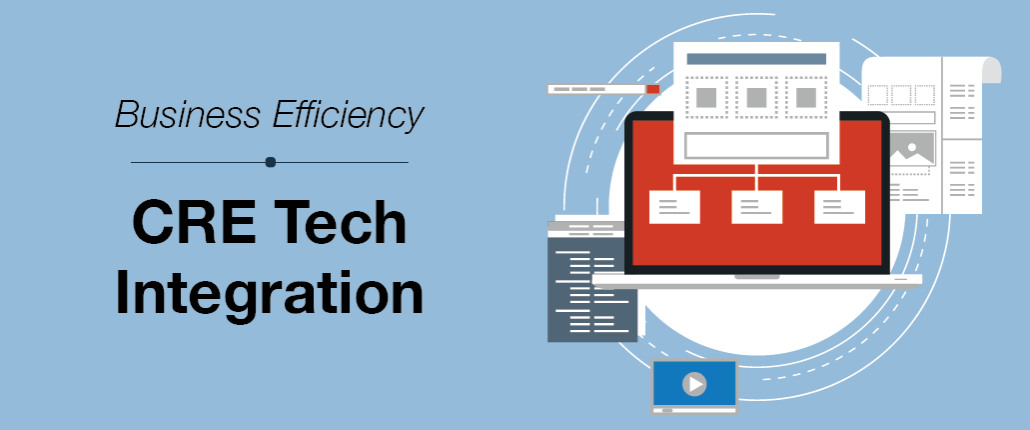You are viewing our site as a Broker, Switch Your View:
Agent | Broker Reset Filters to Default Back to ListThe Next Frontier for Business Efficiency: CRE Tech Integration
April 17 2017

The world of commercial real estate technology is booming. Today's software developers appear to be limitless as to what problems they can solve, and new innovative companies seem to grow by the day. While modern technologies are a welcome change to most in the commercial real estate space, it has led many practitioners to declare, "I subscribe to several software systems. It would be terrific if they were all connected."
With this consistent mention from CRE professionals, naturally the right solution for tech companies to explore is integration. But before we can dive into this concept, it is important to understand how integrations are possible. An Application Programming Interface (API) is a software-to-software interface that allows separate programs to connect in a simple environment. In other words, this software concept allows for the seamless access of a user from one platform into another, or allowing a user access to portions of one software on another program's platform.
"Integrations are the wave of the future in software," says Bruce Kirsch, Founder and CEO of REFM. "Having an API has been on our product road map since day one of Valuate®. We believed then, and still do today, that inter-operability with other platforms is one of the things that makes and keeps a software platform valuable and relevant."
API technology, also known as "geek speak," has enabled RPR Commercial to partner with the Commercial Real Estate (CRE) industry's top technology providers and make a REALTOR's workflow easier and more affordable. In 2016, RPR Commercial partnered with two dynamic technology providers: ClientLook, the most actively used customer relationship manager in CRE; and REFM, the provider of Valuate®, a software-based financial projection analysis tool that help users gain clarity on investment decisions.
"An important part of ClientLook's success is integration with other leading products and services," says Michael Griffin, President and CEO, ClientLook. "The idea is to leverage as much technology as possible under one roof. ClientLook users help prioritize the third party features and workflows that should be incorporated into our CRM experience. And when users talk, we listen."
The key to successful integrations is an understanding of each other's core competency, where the user crossover points are, and what makes the most sense for each partner based on their respective product strategies. For RPR, integration ideas start with a few simple questions such as the below:
- Will this partnership help REALTORS® compete?
- Does the partnership help REALTORS® increase their ability to serve clients?
- Will the partnership create a more efficient workflow for REALTORS® who want to maximize their RPR experience?
If the answer to all three is "yes," and the value add outweighs the cost, the conversation about entering a collaboration commences. Let's take a look at two recent examples:
The ability to generate a property analysis inclusive of demographics, psychographics, and consumer spending data is one of ClientLook's most requested features. This kind of data is key for driving better decisions, although it is typically complex, time-consuming, and expensive to purchase. ClientLook's challenge was to find an easy and intuitive way to deliver these features in a cost effective way.
Through its integration with RPR, ClientLook is now able to provide comprehensive property analysis and reporting features within its application––a simple solution that everyone wanted, and since RPR is a REALTOR® benefit, offered at the right price. Now, every ClientLook property becomes an opportunity to increase client engagement since users can generate highly professional property summaries, demographics, trade area reports, and more. According to Griffin, "Everybody loves the depth of RPR analyses and the simplicity of generating client-ready output with just a single click."
REFM's goal is to provide tools that help global and domestic investors make informed financial decisions. Having the Valuate® investment analysis tool in the hands of as many real estate stakeholders as possible puts REFM closer to that goal.
REFM Founder and CEO Bruce Kirsch echoed those sentiments. "Integrating with RPR meant national distribution of our software to not only REALTORS®, but also to the clients of those REALTORS®. The decision to gain such broad exposure and to team with a respected, technology-oriented operation like RPR was a no brainer."
"Since we integrated last March, we've received invaluable insight from RPR users that has helped shape our product. This is pure gold for testing a relatively new product. Each piece of feedback is a data point that helps us improve the product's capabilities, features, and the user experience," said Kirsch.
Each of these integrations have resulted in mutually beneficial solutions that otherwise would have been timely and costly problems to solve for each entity to on its own. The ultimate outcome from the collaboration has also provided an improved business process by streamlining access to software tools used by CRE professionals.
With one year on the books, and ClientLook and Valuate® integrations proving successful for REALTORS® across the nation, RPR moved full steam ahead to its next value-added partnership, the integration with Xceligent™, a national marketplace promoting commercial properties available for sale or lease. As of March 2017, REALTORS® with CommercialSearch who hold RPR accounts can now easily jump from a CommercialSearch listing to RPR's extensive commercial property and trade area data, investment analysis tools, business intel, and comprehensive reports.
To view the original article, visit the RPR blog.









